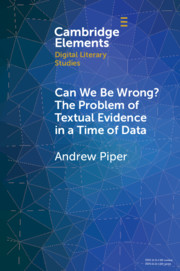Element contents
Can We Be Wrong? The Problem of Textual Evidence in a Time of Data
Published online by Cambridge University Press: 22 September 2020
Summary
Information
- Type
- Element
- Information
- Online ISBN: 9781108922036Publisher: Cambridge University PressPrint publication: 19 November 2020
References
Accessibility standard: Unknown
Why this information is here
This section outlines the accessibility features of this content - including support for screen readers, full keyboard navigation and high-contrast display options. This may not be relevant for you.Accessibility Information
- 23
- Cited by
